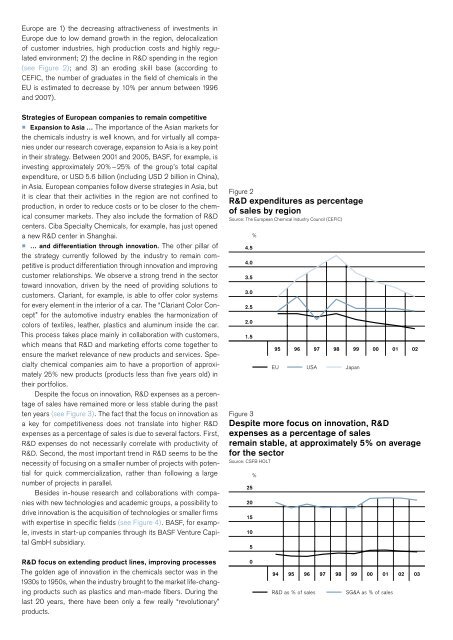Marketing and innovation
New opportunities hit global investors' radar screens Global Investor, 02/2005 Credit Suisse
New opportunities hit global investors' radar screens
Global Investor, 02/2005
Credit Suisse
Create successful ePaper yourself
Turn your PDF publications into a flip-book with our unique Google optimized e-Paper software.
Europe are 1) the decreasing attractiveness of investments in<br />
Europe due to low dem<strong>and</strong> growth in the region, delocalization<br />
of customer industries, high production costs <strong>and</strong> highly regulated<br />
environment; 2) the decline in R&D spending in the region<br />
(see Figure 2); <strong>and</strong> 3) an eroding skill base (according to<br />
CEFIC, the number of graduates in the field of chemicals in the<br />
EU is estimated to decrease by 10% per annum between 1996<br />
<strong>and</strong> 2007).<br />
Strategies of European companies to remain competitive<br />
p Expansion to Asia … The importance of the Asian markets for<br />
the chemicals industry is well known, <strong>and</strong> for virtually all companies<br />
under our research coverage, expansion to Asia is a key point<br />
in their strategy. Between 2001 <strong>and</strong> 2005, BASF, for example, is<br />
investing approximately 20% – 25% of the group’s total capital<br />
expenditure, or USD 5.6 billion (including USD 2 billion in China),<br />
in Asia. European companies follow diverse strategies in Asia, but<br />
it is clear that their activities in the region are not confined to<br />
production, in order to reduce costs or to be closer to the chemical<br />
consumer markets. They also include the formation of R&D<br />
centers. Ciba Specialty Chemicals, for example, has just opened<br />
a new R&D center in Shanghai.<br />
p … <strong>and</strong> differentiation through <strong>innovation</strong>. The other pillar of<br />
the strategy currently followed by the industry to remain competitive<br />
is product differentiation through <strong>innovation</strong> <strong>and</strong> improving<br />
customer relationships. We observe a strong trend in the sector<br />
toward <strong>innovation</strong>, driven by the need of providing solutions to<br />
customers. Clariant, for example, is able to offer color systems<br />
for every element in the interior of a car. The “Clariant Color Concept”<br />
for the automotive industry enables the harmonization of<br />
colors of textiles, leather, plastics <strong>and</strong> aluminum inside the car.<br />
This process takes place mainly in collaboration with customers,<br />
which means that R&D <strong>and</strong> marketing efforts come together to<br />
ensure the market relevance of new products <strong>and</strong> services. Specialty<br />
chemical companies aim to have a proportion of approximately<br />
25% new products (products less than five years old) in<br />
their portfolios.<br />
Despite the focus on <strong>innovation</strong>, R&D expenses as a percentage<br />
of sales have remained more or less stable during the past<br />
ten years (see Figure 3). The fact that the focus on <strong>innovation</strong> as<br />
a key for competitiveness does not translate into higher R&D<br />
expenses as a percentage of sales is due to several factors. First,<br />
R&D expenses do not necessarily correlate with productivity of<br />
R&D. Second, the most important trend in R&D seems to be the<br />
necessity of focusing on a smaller number of projects with potential<br />
for quick commercialization, rather than following a large<br />
number of projects in parallel.<br />
Besides in-house research <strong>and</strong> collaborations with companies<br />
with new technologies <strong>and</strong> academic groups, a possibility to<br />
drive <strong>innovation</strong> is the acquisition of technologies or smaller firms<br />
with expertise in specific fields (see Figure 4). BASF, for example,<br />
invests in start-up companies through its BASF Venture Capital<br />
GmbH subsidiary.<br />
Figure 2<br />
R&D expenditures as percentage<br />
of sales by region<br />
Source: The European Chemical Industry Council (CEFIC)<br />
4.5<br />
4.0<br />
3.5<br />
3.0<br />
2.5<br />
2.0<br />
1.5<br />
25<br />
20<br />
15<br />
10<br />
5<br />
%<br />
95 96 97 98 99 00 01 02<br />
EU USA Japan<br />
Figure 3<br />
Despite more focus on <strong>innovation</strong>, R&D<br />
expenses as a percentage of sales<br />
remain stable, at approximately 5% on average<br />
for the sector<br />
Source: CSFB HOLT<br />
%<br />
R&D focus on extending product lines, improving processes<br />
The golden age of <strong>innovation</strong> in the chemicals sector was in the<br />
1930s to 1950s, when the industry brought to the market life-changing<br />
products such as plastics <strong>and</strong> man-made fibers. During the<br />
last 20 years, there have been only a few really “revolutionary”<br />
products.<br />
0<br />
94 95 96 97 98 99 00 01 02 03<br />
R&D as % of sales<br />
SG&A as % of sales

















